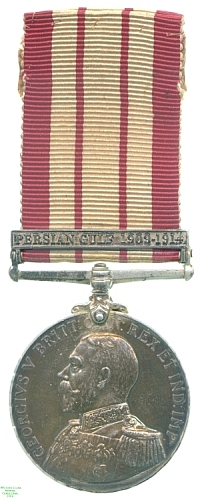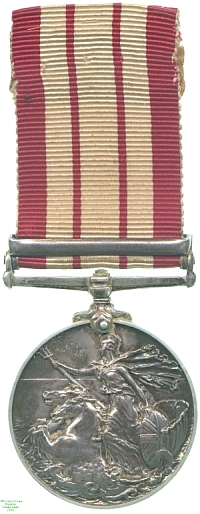
Obverse, a portrait of King George V in naval uniform facing left

Reverse, Britannia riding two seahorses through the waves, carrying a trident and the Union shield

Obverse, a portrait of King George V in naval uniform facing left |

Reverse, Britannia riding two seahorses through the waves, carrying a trident and the Union shield |
By 1915 it had become clear that the Great War would be a long time in the fighting, and that a number of small operations would arise that, although worthy of recognition by medals, would not merit a separate award. A new Naval General Service Medal was therefore instituted. In the event, services in the Great War's campaigns at sea were recognised by other medals, general such as the British War Medal or more specific like the Mercantile Marine War Medal, but some unrelated operations were recognised by awards of the new NGSM. The Medal was issued until 1962, and although it was then replaced by the General Service Medal, a final bar was awarded to the NGSM in 2005, for operations in the Suez Zone fifty years earlier! At the time of writing therefore claims for NGSMs are still being considered.
Just as this award of the medal postdates its currency, the first campaign for which it was awarded predated it, that being service aboard any of 25 Royal Navy or other vessels that had been involved in patrols against pirates and gun-runners in the Persian Gulf, Straits of Hormuz or the Sea of Oman between 1909 and 1914.
This medal was awarded to Able Bodied Seaman P. Redmond, who served aboard the 3rd-class cruiser HMS Proserpine. This is one of two medals that were awarded to him that are now in the Watson Collection; the other precedes this. The medals are not attached to each other so although the Watson Collection catalogue considers them as Group 4 they have been treated separately here. Nonetheless, it was as a group that Lester Watson purchased them from the London dealer Spink, in 1926.